| Neglected children will sometimes bang their heads against their cribs or a wall to create colorful lights in their heads and, hopefully, get people to come and pay attention to them. Adults often engage in "head banging" as they try to arouse a response from people whose attention they seek. They will call, send e-mails and even give gifts even though there is no response or real appreciation. Sometimes, the head-bangers get furious at people who do not respond. Their fury is like a light show which enables them to feel that some form of relationship is taking place, even though it is only in their own minds. If you are continuously reaching out to people who rebuff, insult or ignore you, it is time for a change. It is not easy to stop this head-banging "addiction," especially if you've spend many years engaged in this activity, but it is possible. Put your energies to good use. There are volunteer organizations where people will appreciate your good heart and your desire for connection.
Love Yehuda Lave |
|
|
| Conversations 
Primary Your Primary tab is empty. Personal messages and messages that don't appear in other tabs will be shown here. To add or remove tabs click inbox settings. | |  | Click to teach Gmail this conversation is important. | Wells Fargo Online (10), Wells Fargo online statement ready to view, Mar 2, wellsfargo.com Your new statement is now available online The new statement for your Wells Fargo deposit account XXXXXX1828 is now available to view online. To view your statement from a browser: 1. Go. Wells Fargo Online (10) | Wells Fargo online statement ready to view - wellsfargo.com Your new statement is now available online The new statement for your Wells Fargo deposit account XXXXXX1828 is now available to view online. To view your statement from a browser: 1. Go | | Mar 2 | | |  | Important according to Google magic.
Click to teach Gmail this conversation is not important. | unread, abraham djemal, (no subject), Feb 18, נשלח מה-iPhone שלי. abraham djemal | (no subject) - נשלח מה-iPhone שלי | | Feb 18 | | |  | Important mainly because of the people in the conversation.
Click to teach Gmail this conversation is not important. | Deena Sattler, Fwd: RV: Jewish Genius, has attachments, 11/5/17, Forwarded message From: Daniel Morgenstern <danielmorg1948@gmail.com> Date: Fri, Nov 3, 2017 at 2:06 PM Subject: Fwd: RV: Jewish Genius To: "edna.leiman@gmail.com". Deena Sattler | Fwd: RV: Jewish Genius - Forwarded message From: Daniel Morgenstern <danielmorg1948@gmail.com> Date: Fri, Nov 3, 2017 at 2:06 PM Subject: Fwd: RV: Jewish Genius To: "edna.leiman@gmail.com" |  | 11/5/17 | | |  | Important mainly because it was sent directly to you.
Click to teach Gmail this conversation is not important. | unread, mali amar-leitner, FW: Happy 68th Birthday, Israel!, 5/15/16, Dear friends and family, Indeed Happy 68th birthday to my beloved home land my birth country. Please. mali amar-leitner | FW: Happy 68th Birthday, Israel! - Dear friends and family, Indeed Happy 68th birthday to my beloved home land my birth country. Please | | 5/15/16 | | |  | Click to teach Gmail this conversation is important. | unread, noreply@simplevoicebox.c., SimpleVoiceBox Activity Report, 4/2/16, Thank you for using SimpleVoiceBox. Below you will find the details related to activity in your. noreply@simplevoicebox.c. | SimpleVoiceBox Activity Report - Thank you for using SimpleVoiceBox. Below you will find the details related to activity in your | | 4/2/16 | | |  | Click to teach Gmail this conversation is important. | Larry Lave, stock statment, has attachments, 2/11/15, Forwarded message From: Postmaster <alert@email-alert2.com> Date: Sun,. Larry Lave | stock statment - Forwarded message From: Postmaster <alert@email-alert2.com> Date: Sun, |  | 2/11/15 | 
Social Your Social tab is empty. Emails from social networks, media-sharing sites, dating services and other social sites will be shown here. To add or remove tabs click inbox settings. 
Promotions Your Promotions tab is empty. Deals, offers and other marketing emails will be shown here. To add or remove tabs click inbox settings. Conversations | |  | Important according to Google magic.
Click to teach Gmail this conversation is not important. | Marsha Schiffman, McCabe Firing, Dan Bongino Show, 12 minute video, 7:40 am, Yehuda, Thank you so much for your condolence message. Ethel was and remains a blessing and she will be most missed by many people. Since Sid and Charlie z"l passed on it was very difficult for. Marsha Schiffman | McCabe Firing, Dan Bongino Show, 12 minute video - Yehuda, Thank you so much for your condolence message. Ethel was and remains a blessing and she will be most missed by many people. Since Sid and Charlie z"l passed on it was very difficult for | | 7:40 am | | |  | Click to teach Gmail this conversation is important. | Marsha Schiffman, Obama is at it again.Concerned about his crumbling legacy and unable to bear life out o..., Mar 10, https://www.americanthinker.com/blog/2018/03/with_netflix_obama_building_another_monument_to_himself.html#.WqMoOy2MISk.gmail marsha. Marsha Schiffman | Obama is at it again.Concerned about his crumbling legacy and unable to bear life out o... - https://www.americanthinker.com/blog/2018/03/with_netflix_obama_building_another_monument_to_himself.html#.WqMoOy2MISk.gmail marsha | | Mar 10 | | |  | Important according to Google magic.
Click to teach Gmail this conversation is not important. | Marsha, Yehuda (2), Re: Scientists see first light of the Universe 14 billion Years ago, Mar 9, I do my best From: Marsha Schiffman <crs1818@gmail.com> Sent: Friday, March 9, 2018 7:41:46 AM To: Yehuda Lave; Rabbi Yehuda Lave Subject: Re: Scientists see first light of the Universe 14. Marsha, Yehuda (2) | Re: Scientists see first light of the Universe 14 billion Years ago - I do my best From: Marsha Schiffman <crs1818@gmail.com> Sent: Friday, March 9, 2018 7:41:46 AM To: Yehuda Lave; Rabbi Yehuda Lave Subject: Re: Scientists see first light of the Universe 14 | | Mar 9 | | |  | Important according to Google magic.
Click to teach Gmail this conversation is not important. | Marsha Schiffman, Fwd: an article about the teacher and the preacher, Feb 28, About The Teacher and The Preacher, Charlie's z"l radio show that he began with Pastor Dave McGarrah and includes some info about Charlie. marsha Forwarded message From:. Marsha Schiffman | Fwd: an article about the teacher and the preacher - About The Teacher and The Preacher, Charlie's z"l radio show that he began with Pastor Dave McGarrah and includes some info about Charlie. marsha Forwarded message From: | | Feb 28 | | |  | Important according to Google magic.
Click to teach Gmail this conversation is not important. | Marsha Schiffman, Fwd: Trailer, Feb 5, fyi marsha Forwarded message From: <cdenbo@comcast.net> Date: Mon, Feb 5, 2018 at 7:54 AM Subject: Trailer To: >>> >>> https://www.thefightofourlives.com/. Marsha Schiffman | Fwd: Trailer - fyi marsha Forwarded message From: <cdenbo@comcast.net> Date: Mon, Feb 5, 2018 at 7:54 AM Subject: Trailer To: >>> >>> https://www.thefightofourlives.com/ | | Feb 5 | | |  | Important according to Google magic.
Click to teach Gmail this conversation is not important. | Marsha, me (5), Fwd: biometric surveillance, Feb 5, Yehuda, It was more than that. I listened because someone from Maale Adumim who is religious was disturbed by it and sent it to me because she was disturbed by it. What was even more disturbing was the. Marsha, me (5) | Fwd: biometric surveillance - Yehuda, It was more than that. I listened because someone from Maale Adumim who is religious was disturbed by it and sent it to me because she was disturbed by it. What was even more disturbing was the | | Feb 5 | | |  | Important according to Google magic.
Click to teach Gmail this conversation is not important. | Marsha Schiffman, Michael Savage on SOTU and future of the USA, Feb 1, https://youtu.be/ORBmXvMSgis Really good show today 1.31.18. Very optimistic and upbeat. from marsha. Marsha Schiffman | Michael Savage on SOTU and future of the USA - https://youtu.be/ORBmXvMSgis Really good show today 1.31.18. Very optimistic and upbeat. from marsha | | Feb 1 | | |  | Important according to Google magic.
Click to teach Gmail this conversation is not important. | Marsha Schiffman, Glazov Gang: Islam's Claim to the Temple Mount new documentary film trying to prove the..., Jan 31, https://www.jihadwatch.org/2018/01/glazov-gang-islams-claim-to-the-temple-mount from marsha schiffman. Marsha Schiffman | Glazov Gang: Islam's Claim to the Temple Mount new documentary film trying to prove the... - https://www.jihadwatch.org/2018/01/glazov-gang-islams-claim-to-the-temple-mount from marsha schiffman | | Jan 31 | | |  | Important according to Google magic.
Click to teach Gmail this conversation is not important. | unread, Marsha Schiffman, Fwd: hagmann coup, Jan 29, Hagmann lays out critical information about the attempt to take down Donald Trump in this 12 minute youtube. Definitely recommended and worth your time. marsha Forwarded message . Marsha Schiffman | Fwd: hagmann coup - Hagmann lays out critical information about the attempt to take down Donald Trump in this 12 minute youtube. Definitely recommended and worth your time. marsha Forwarded message | | Jan 29 | | |  | Important according to Google magic.
Click to teach Gmail this conversation is not important. | Marsha Schiffman, President Trump's fantastic pro life address, Jan 21, https://youtu.be/RjeeL5DQaYw Bravo President Trump! Working to bring back the idea of the sanctity of life and the strong family into American life. With over fifty four million abortions officially. Marsha Schiffman | President Trump's fantastic pro life address - https://youtu.be/RjeeL5DQaYw Bravo President Trump! Working to bring back the idea of the sanctity of life and the strong family into American life. With over fifty four million abortions officially | | Jan 21 | | |  | Important according to Google magic.
Click to teach Gmail this conversation is not important. | unread, Marsha Schiffman, Fwd: Viewpoint: What I Learned in Peace Corps in Africa: Trump is Right, Jan 17, Wow! The Peace Corps can provide quite an education in what the world is really like. marsha Forwarded message Date: Wed, Jan 17, 2018 at 11:05 AM Subject: Viewpoint: What I. Marsha Schiffman | Fwd: Viewpoint: What I Learned in Peace Corps in Africa: Trump is Right - Wow! The Peace Corps can provide quite an education in what the world is really like. marsha Forwarded message Date: Wed, Jan 17, 2018 at 11:05 AM Subject: Viewpoint: What I | | Jan 17 | Obama is at it again.Concerned about his crumbling legacy and unable to bear life out of the spotlight, the former president is in talks with Netflix "to produce a series of high-profile shows that will provide him a global platform after hi..
| |
|
|
Terrorists firebomb Jerusalem hospital 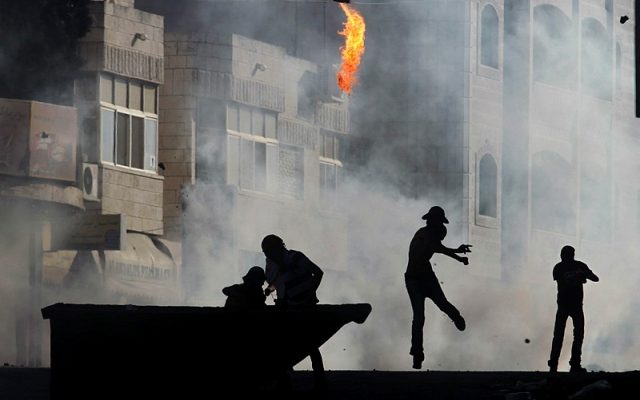 A Palestinian terrorist throws a fire bomb. (Issam Rimawi/Flash90)
A firebomb thrown at a Hadassah Hospital in Jerusalem was the third such attack by Arab terrorists in a week. By: World Israel News Staff Arab terrorists threw two firebombs at Hadassah Hospital's Mount Scopus campus in Jerusalem Monday night. The bomb caught fire but no one was injured and no damage was caused in the attack. Israel's 0404 news reported that this was the third such attack over the past week. The majority of the patients at the hospital are Arab. |
|
|
mportance of Bats
The newsletter from, "The Texas Gardener Seeds" said: Put up a bat house to encourage the presence of these shy animals.
Bats consume 3,000 or more mosquitoes and other insects nightly, and bats are l ess likely to be rabid than dogs are.
Need another reason?
Bats are responsible for up to 95 percent of the seed dispersal essential to the regeneration of forests.
Our planet is populated with plenty of bizarre
and astonishing creatures.
Here are three from the Bat Family
![[]](https://mail.google.com/mail/u/0/?ui=2&ik=acaed5db31&view=fimg&th=1621d4550296ddcb&attid=0.1&disp=emb&realattid=2ee0bd33a11b80ff_0.1.1&attbid=ANGjdJ9UMLjaMh0CA6TNvRUSYeW9c8C_pPscltq69dt4QcusAc8gBnusP7UbQUcjflmOD21G7GNtSFh0S3GTr5ZXRCVQmh02C15tDFRmxUJYcmqgh0dIg3S4i9kmwgU&sz=w768-h548&ats=1521344838099&rm=1621d4550296ddcb&zw&atsh=1)
Sucker-footed Bat

Red-Winged Fruit Bat
![[]](https://mail.google.com/mail/u/0/?ui=2&ik=acaed5db31&view=fimg&th=1621d4550296ddcb&attid=0.2&disp=emb&realattid=2ee0bd33a11b80ff_0.1.3&attbid=ANGjdJ-o4ynWLf5Rqc9tQBBdEgKYnIK5QMMjMClvHbcmR35wRY-xrIJq5H4pCQxiJMS5mZAAI7WdD2S-0VmwKyYHjX_J1El-hkQskYN5M1h_9E9e4wiB42WTCH-57no&sz=w504-h600&ats=1521344838101&rm=1621d4550296ddcb&zw&atsh=1)
Left-Winged Ding Bat So 2 out of 3 Bats have a useful purpose!
If we could just train her to eat mosquitoes...or anything useful ! |
|
|
Zoya Cherkassky paints her truth in first solo Israel Museum exhibition Unafraid to shock and offend, Kiev-born artist uses edgy humor and crass stereotypes to portray mass post-Soviet aliya experience Artist Zoya Cherkassky recently gave journalists a tour of her first solo exhibition at the Israel Museum in Jerusalem. As she approached the final section, she stopped and turned to the group. "Okay, now we are entering the scary room," Cherkassky warned. The "scary room" contained large oil paintings, including one called "The Circumcision of Uncle Yasha" depicting the bloody removal of a middle aged man's penile foreskin by surgeons sporting side locks, their faces obscured by religious books. Another painting titled "Aliya of the 1990's" was a pornographic image of a mostly nude blonde woman bent over, displaying her genitals. A third, "Itzik," portrayed a wild-eyed, swarthy Middle Eastern falafel store owner grabbing his terrified blonde Russian waitress. 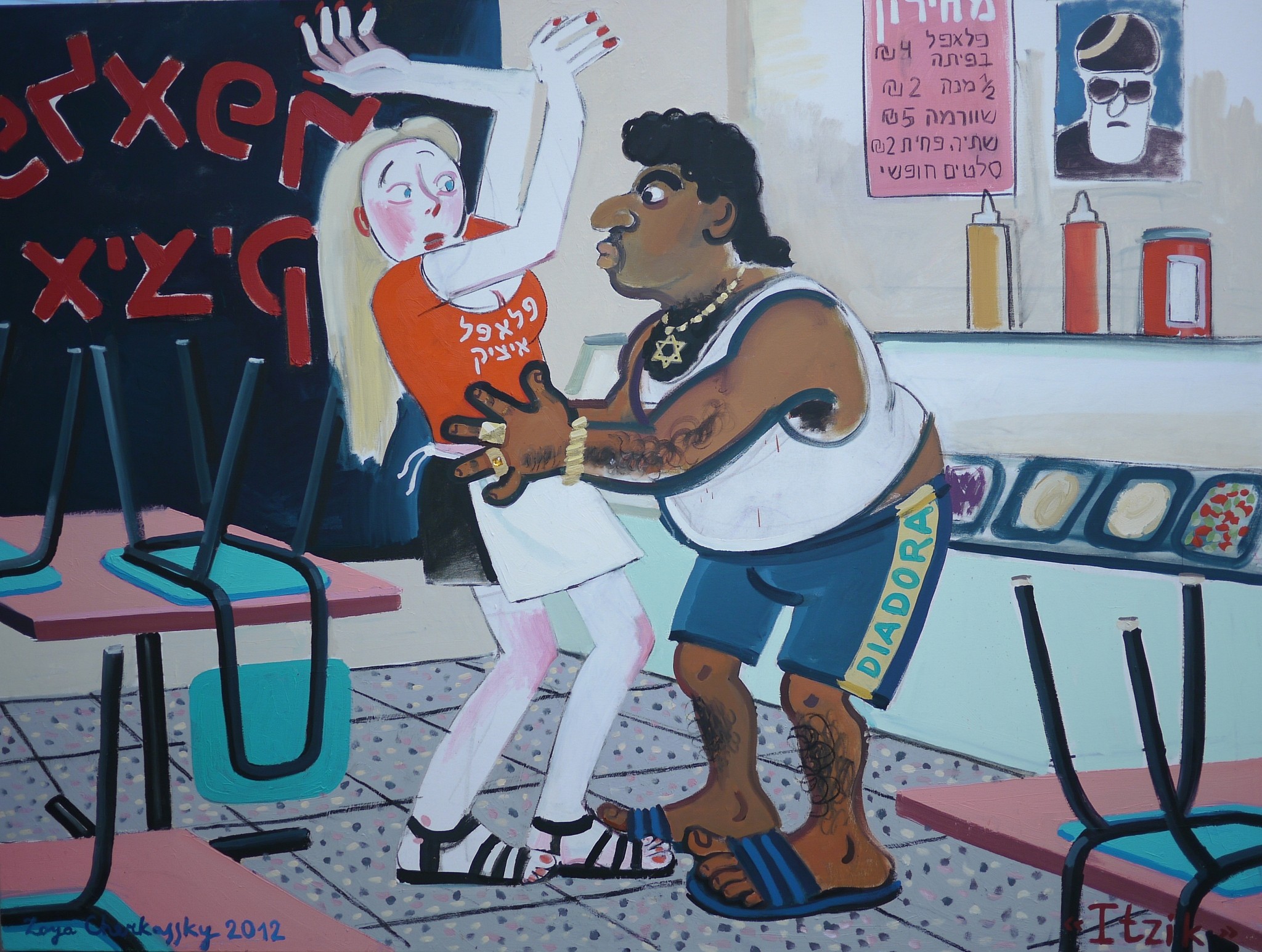 'Itzik,' Zoya Cherkassky, 2012. Oil on canvas, 150×200 cm. Private collection (Courtesy of Israel Museum) While the rest of the exhibition's works may be less graphic and traffic in fewer crass stereotypes, they are almost equally disturbing. Cherkassky's caricaturesque style and use of bubble gum colors that pop from the canvas belie her subject matter. Her works have humor, but no real joy. She means to provoke, forcing viewers to confront the harsh realities faced by the 1 million immigrants to Israel from the former Soviet Union following the fall of the Iron Curtain as they tried to adjust socially, culturally and religiously. The 25 oil paintings and the 80 works on paper in the exhibition chosen by senior curator of Israeli art Dr. Amitai Mendelsohn and titled, "Pravda" (truth in Russian, and the name of the former official newspaper of the Soviet Communist Party) depict not only the absurdities and frictions of the new immigrants' experiences, but also their lives back in the USSR. In some images, a sense of nostalgia is present, but in others, the artist lays bare the failures of Communism and the Soviet Union. 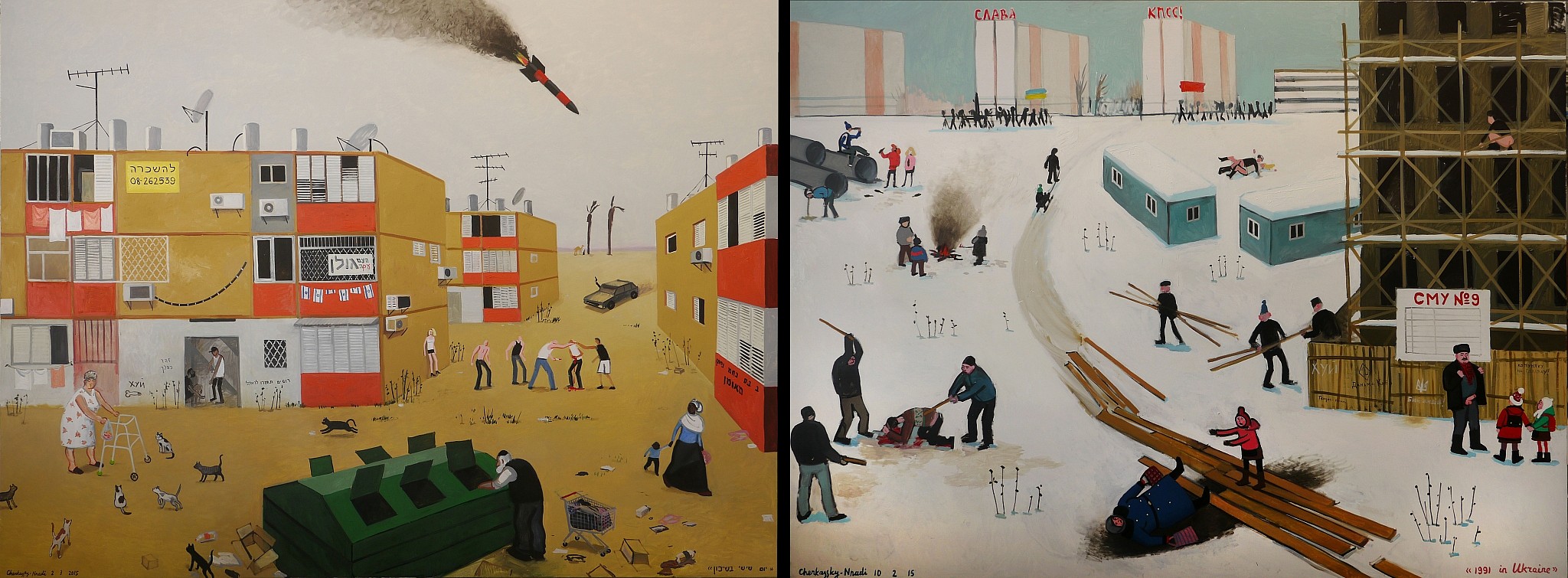 '1991 Ukraine'; 'Friday in the Projects' (diptych), Zoya Cherkassky, 2015. Oil on linen, 200×270 cm each, Israel Museum purchase. (Courtesy Israel Museum) Nowhere is this more evident than in a large diptych comprised of "1991 in Ukraine" and "Friday in the Projects." The former shows a snow-covered open area near a construction site, with industrial buildings in the distance. It's a horrific scene of debauchery and multiple types of violence: A man rapes a woman, a man exposes himself to children, and a group of men beat an individual bloody. The latter painting is equally disturbing, depicting a poor neighborhood in the Negev desert city of Beersheva. There, young men stab one another, junkies shoot up in a doorway, and a missile falls from the sky. The message is clear: It's been out of the frying pan and into the fire for the Soviet Jews (and their non-Jewish family members) who moved to Israel. Soviet Communism and Israeli Zionism are both failed utopias. The memories depicted in "Pravda" are collective in some cases, and personal in others. 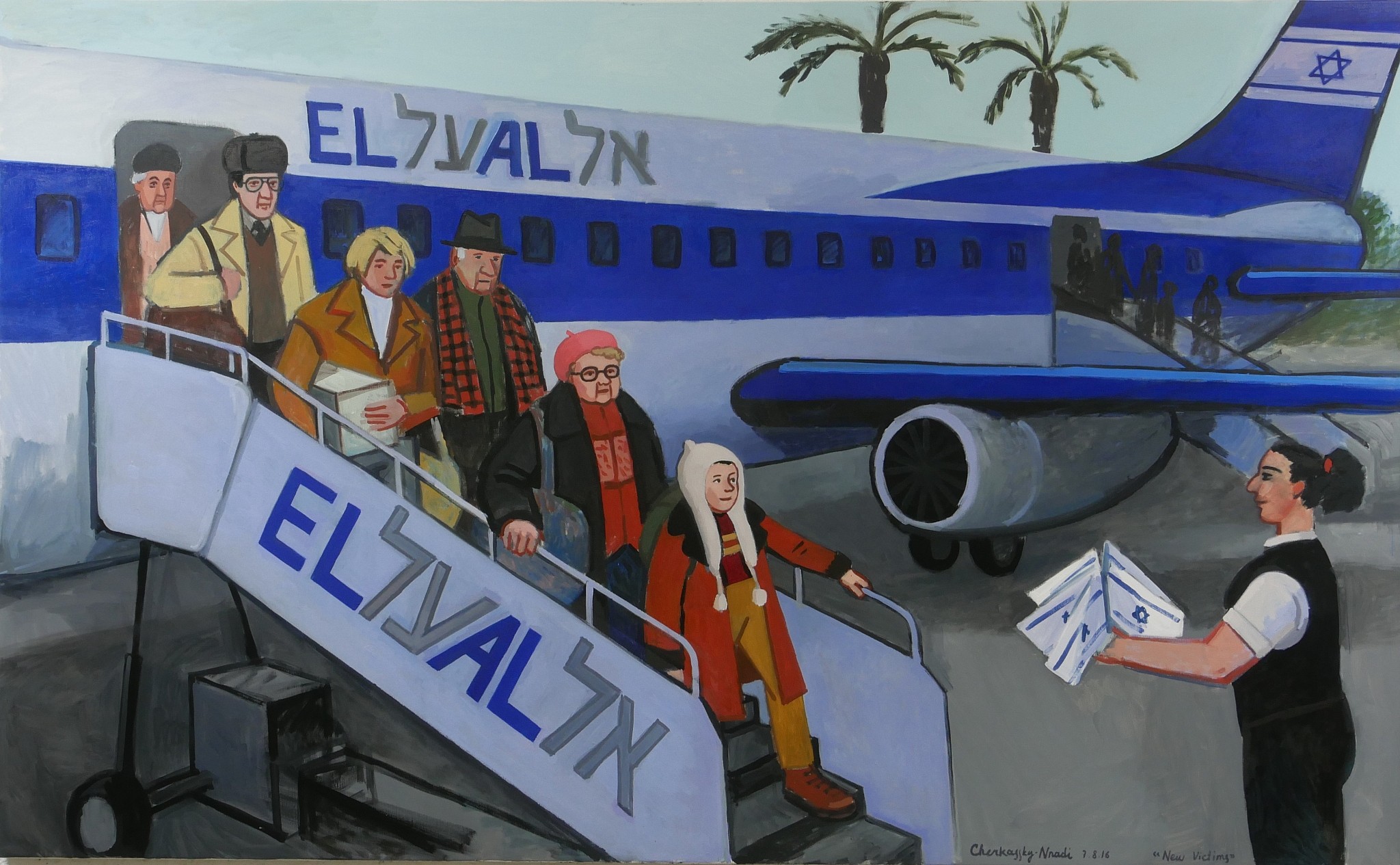 'New Victims,' Zoya Cherkassky, 2016. Oil on linen, 140×230 cm. Courtesy of the artist and Rosenfeld Gallery. (Courtesy of Israel Museum) Cherkassky, 41, herself arrived in Israel from Kiev, Ukraine during the massive immigration wave. Her landing in December 1991 was more or less soft, with her parents sorting out their employment situations relatively quickly. Cherkassky, who had studied drawing and painting seriously from a very young age, was admitted within less than a week to 9th grade at the prestigious Thelma Yellin High School of the Arts in Tel Aviv. She continued her studies at Beit Berl College. Although Cherkassky's family thought of itself as Jewish in the Soviet Union, in Israel, the artist is not considered Jewish by the religious law of matrilineal descent. "My father's parents were both Jewish, but my mother is Jewish on the wrong side," she said. 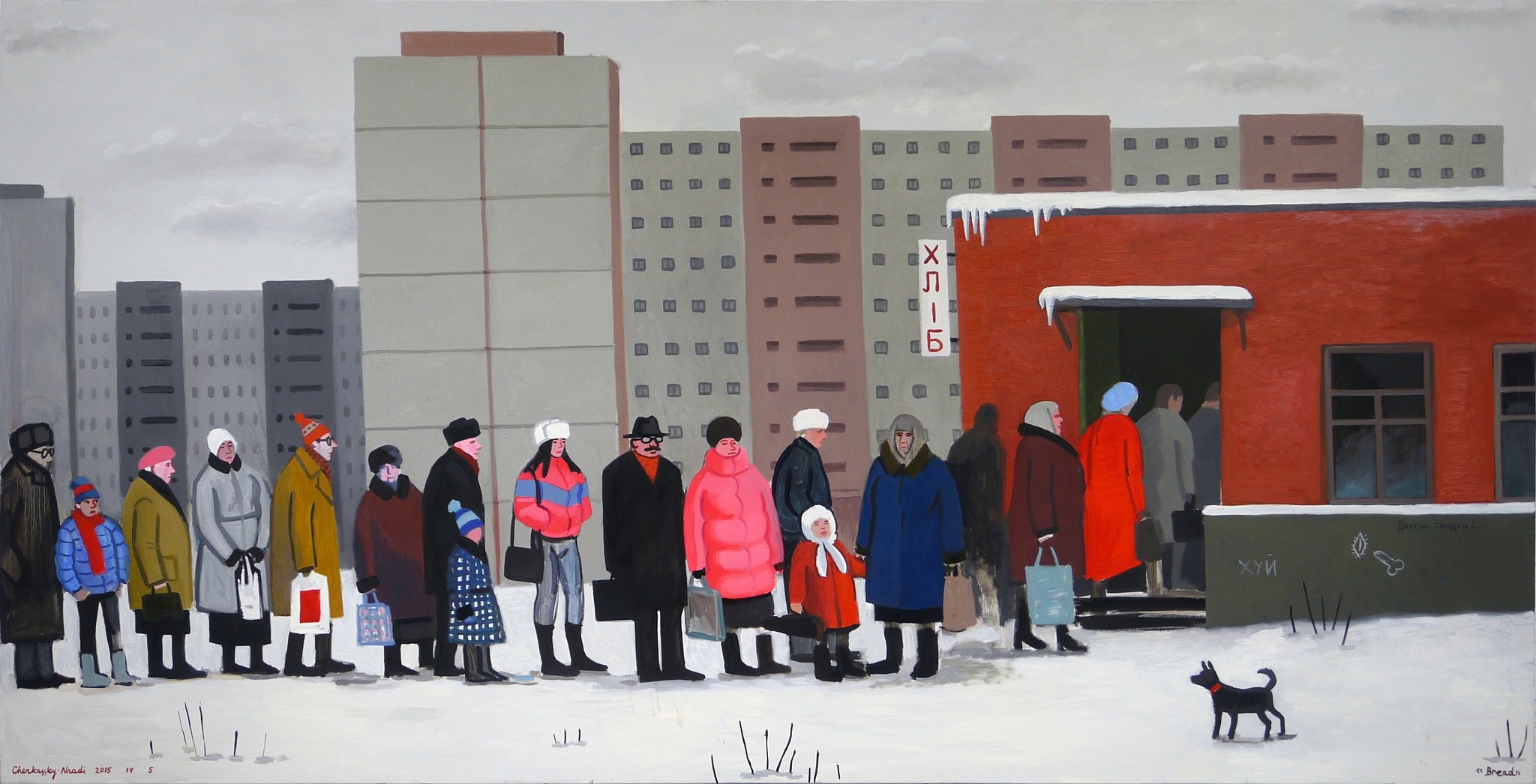 'Bread,' Zoya Cherkassky 2015. Oil on linen 120 x 240 cm. Private Collection. (Courtesy of Israel Museum) Cherkassky said in an interview with Haaretz that she moved primarily in artistic circles for her first decade and a half as an Israeli and did not develop a political consciousness until she was around 30, upon returning to Israel in 2009 after several years in Berlin. At that point, she began leaving her studio to go out into the streets of Israel, and also into Palestinian refugee camps in the West Bank, to paint. Cherkassky also co-founded New Barbizon, a collective of five Russian-Israel women artists focused on realism. One of Cherkassky's forays into the streets near her south Tel Aviv studio in search of models resulted in her meeting her husband, a Nigerian man. The couple has a young daughter who they send to a Russian-language kindergarten. Cherkassky, who defines her style as social realism, is at this point an avowed and vocal communist. "In my opinion, only communism can be an alternative to the extreme right and fascism. All those liberals can't give it any fight," she told Haaretz. 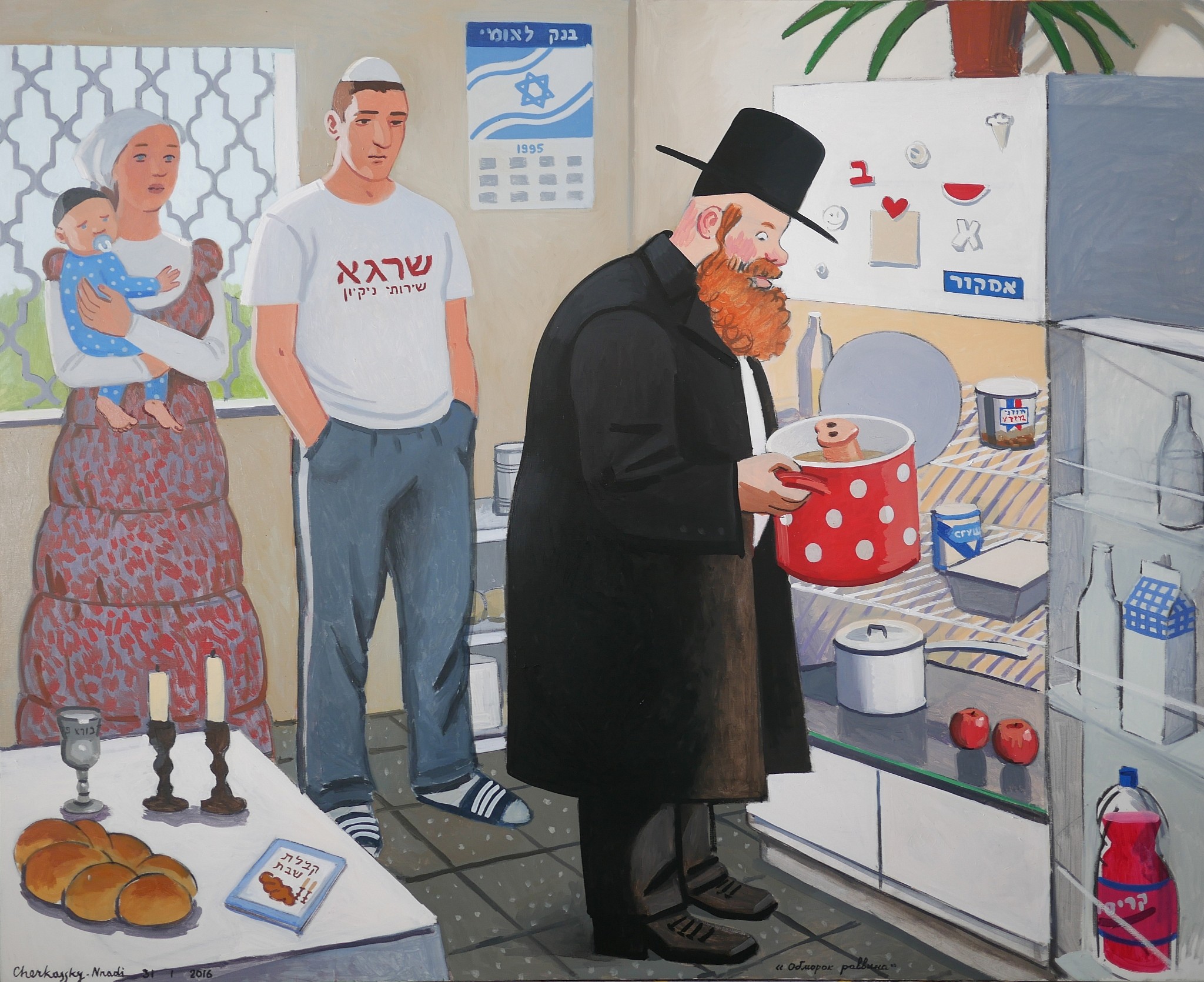 'Rabbi's Deliquium,' Zoya Cherkassky, 2016. Oil on linen, 120×150 cm. Collection of the Lerer family (Courtesy of Israel Museum) While some of Cherkassky's paintings, like "One Day of Ivan Denisovich in Israel" showing a poor, elderly Russian man scrounging for rotting vegetables at the market, highlight the difficult plight of immigrants, others point to the refusal of many Russians to fully integrate into Israeli society. "Russian olim [immigrants] did not enter the melting pot. They speak Russian with their children, send them to Russian kindergartens, and shop in supermarkets and stores stocked with Russian foods," Cherkassky said. "For Russians, there is no such thing as kosher," she said. Cherkassky illustrates this point humorously in "Rabbi's Deliquium," in which an ultra-Orthodox rabbi comes to check on a young Russian immigrant couple who are undergoing Orthodox conversion to Judaism. They look the part, with the husband wearing a yarmulke and the wife dressed modestly. But when the rabbi opens the refrigerator, he comes face to face with a pink, non-kosher pig's snout sticking out from a pot. "They Eat Russian Lard," one of the two paintings at the entrance to the show, portrays the same idea. Here is a deli counter filled with a variety of pork products placed alongside an array of cheeses. Some of the meat and cheese overlap, and one type of bologna is even labeled "dairy meat." Definitely not kosher. 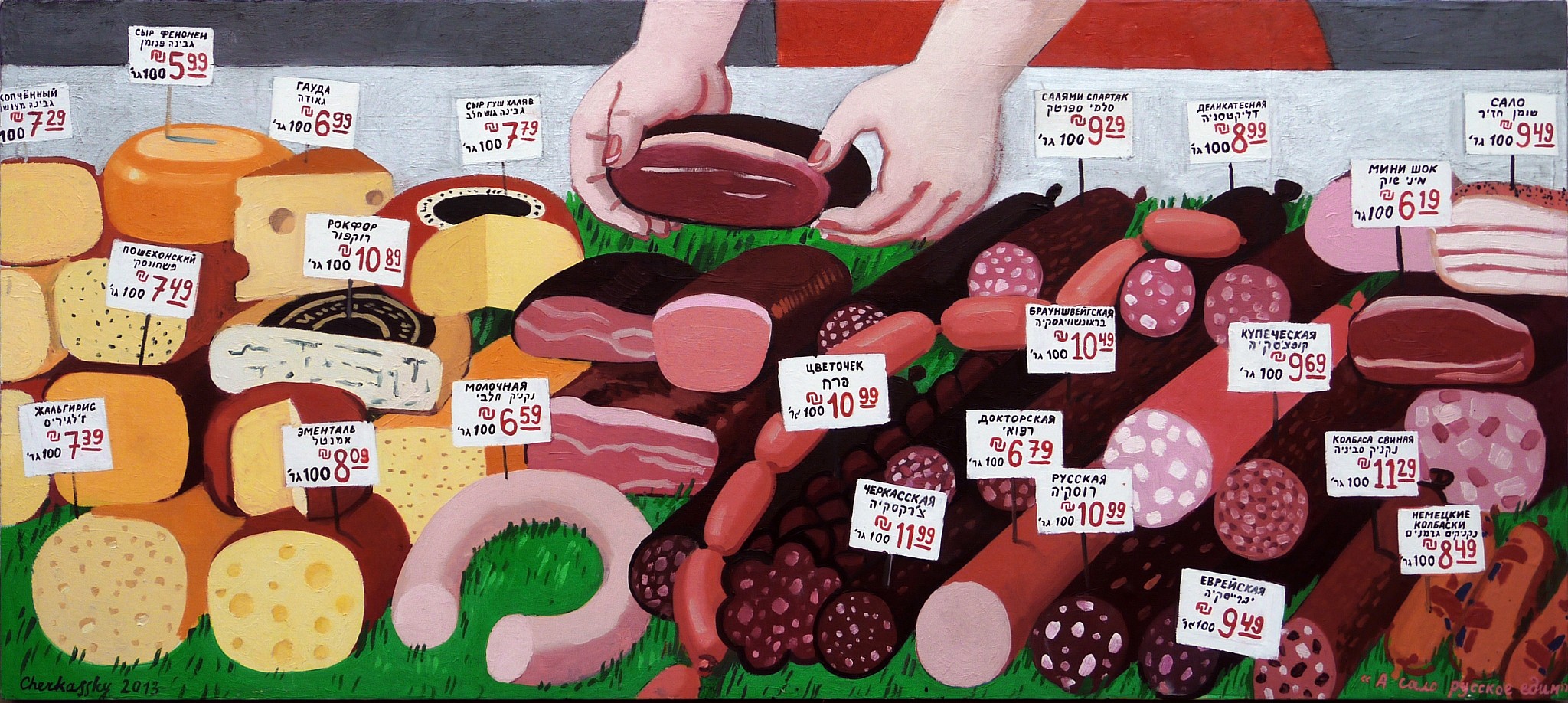 'They Eat Russian Lard,' Zoya Cherkassky, 2013. Oil on canvas mounted on wood, 70×159 cm. Yurai David collection. (Courtesy of Israel Museum) The entire exhibition is impressive, but it's hard to get the "scary room" out of one's mind. Cherkassky doesn't shy away from being grotesque or exaggerating stereotypes to make her point. She also isn't deterred by the hateful names she's been called, like "slut" when walking on the street with her husband, and "racist" when she first shared her "Itzik" painting publicly a few years ago. "Israelis think Russians are whores and Russians think Israelis are monkeys. This painting and the others in this room are about how Israeli society is soaked with stereotypes from all directions," Cherkassky said. Already known among collectors of Israeli art and represented by the prestigious Rosenfeld Gallery, Cherkassky reported that prices for her works, which range between $600 and $40,000, have already risen since the exhibition opened on January 10. To Cherkassky, this solo show at the Israel Museum signals that she has achieved mainstream status. It's a major honor for such a young, foreign-born artist. It's one she earned with her talent — and also what is tattooed across her forearm: Attitude. "Pravda" runs at the Israel Museum until October 31, 2018 |
|
|
Photo Credit: IDF Spokesperson's Unit  Hamas rockets now threaten the majority of the State of Israel. {Originally posted to the author's website, Abu Yehuda} When I was in elementary school, I was disciplined for hitting another pupil after he hit me. That I remember the details of the incident clearly 60-odd years later is an indication of how strongly I perceived the injustice of it. I believed my action was justified as necessary self-defense to stop an unprovoked attack. The school principal disagreed. Advertisement One of the most strongly felt principles in Western morality and jurisprudence is the right of self-defense. It is permissible in most places to kill an attacker when a person feels that his own life or that of a family member is threatened. A person is not required to allow himself to be harmed or killed, even if the action he is forced to take to protect himself would be otherwise immoral or illegal. There are strong arguments that even convicts have a constitutional right to employ violence in self-defense in the pervasively violent environment of American prisons. Prisons are inherently violent and dangerous, and the authorities are not able to protect the prisoners' rights given budgetary and other constraints. But incarceration does not include a requirement to commit suicide, which in many cases is what failing to defend oneself in prison means. There is the well-known Talmudic dictum, "If a man comes to kill you, rise up and kill him first" (Sanhedrin 72:1). And even Islamic shari'a recognizes a right of self-defense (although a non-Muslim may not be able to exercise it against a Muslim for other reasons). The right of self-defense is also recognized internationally between states. The UN Charter (Ch. I, Art. 2.4) says that members "shall refrain in their international relations from the threat or use of force against the territorial integrity or political independence of any state, or in any other manner inconsistent with the Purposes of the United Nations." But the last article (51) of Chapter VII, which defines how the UN itself may use force to stop aggression, includes this exception: Nothing in the present Charter shall impair the inherent right of individual or collective self-defence if an armed attack occurs against a Member of the United Nations, until the Security Council has taken measures necessary to maintain international peace and security. [my emphasis] The International Court of Justice (ICJ), in its 1996 Advisory Opinion on the Legality of the Use or Threat of Nuclear Weapons, took note of "the fundamental right of every State to survival, and thus its right to resort to self-defence, in accordance with Article 51 of the Charter, when its survival is at stake." The Court argued that in such a case, as long as they are used in concurrence with international humanitarian law (in particular, the principles of necessity and proportionality), even nuclear weapons could not be ruled illegal! The right of individual self-defense derives from the most basic of human rights, the right to life. And as the UN Charter and ICJ opinion quoted above indicate, international law recognizes also a national right to life. I believe that the Middle East, like an American prison, is an inherently violent and dangerous place, and that all states – even one unwelcome to its neighbors – have the right to defend themselves when attacked, using whatever means are necessary to do so. Even, when there is no other option, nuclear weapons. A lot is packed into the words "when attacked." For example, in 1973, Israel's enemies crossed cease-fire lines and attacked Israeli positions, acts that unambiguously constituted an "attack." In 1967, Egypt expelled UN peacekeepers from the Sinai, massed armored divisions on the Suez Canal, announced that they would "annihilate" the Jewish state and "slaughter" us (here is a recording of Radio Cairo threatening genocide in Hebrew), and closed the Strait of Tiran, which in itself was an act of war. Technically Israel fired the first shot on June 5, but from a practical and legal standpoint, Egypt and Syria were the aggressors. The situation today is not as clear. Iran, operating through proxies, has built an offensive capability in southern Lebanon over the past decade, and now is doing the same in Syria. It has threatened us with genocide and financed terrorists of all stripes. But its buildup has been gradual and it has not yet taken actions equivalent to the expulsion of the UN peacekeepers from the Sinai or the blockade of the Strait of Tiran. At some point the line will be crossed, and Israel will need to take military action. Unfortunately, the attitude of the international community – as expressed in UN resolutions, NGO reports, media content, and institutions like the ICJ – does not grant to Israel the same right of self-defense that every other nation is given. Even when Israel has been attacked, as by the massive flood of Hezbollah rockets in 2006, or the rocket barrages from Gaza in 2008, 2012 or 2014, the Islamic-European-NGO-media axis has defined Israel as the aggressor and even accused her of war crimes for her responses. These accusations, based on cooked numbers and reports coming directly from Hamas, Hezbollah, or other severely biased anti-Israel sources, were even echoed by US President Obama, Secretary of State John Kerry and other administration officials. Israel's efforts to reduce collateral damage in these campaigns were unprecedented, and the resultant protection of civilian life and property was far better than the US and its NATO partners have been able to achieve in various recent conflicts. But the war crimes accusations against us stuck nevertheless. The ICJ, whose very careful and comprehensive opinion on the use of nuclear weapons was quoted above, also produced one in 2004 on the subject of Israel's security barrier. In this highly politicized opinion, The Court reiterated all of the usual Arab and European talking points, calling the barrier illegal and declaring that Israel must dismantle it, pay compensation to all those "injured" by it, and so forth (fortunately, the Court does not have the power to force Israel to follow its advice). Israel argued that the existence of the barrier and its location were intended to protect her population from armed attacks. But the Court simply rejected this without any investigation of the facts or attempt to rebut Israel's claims of military necessity. It misinterpreted Article 51 of the UN Charter, saying that since Israel "controlled" the territories, she did not have a right to protect herself from armed attacks from them. And there were other significant deficiencies. Here is a small part of the criticism leveled against the decision by the one dissenting justice, Thomas Buergenthal (the only American on the Court): All we have from the Court is a description of the harm the wall is causing and a discussion of various provisions of international humanitarian law and human rights instruments followed by the conclusion that this law has been violated. Lacking is an examination of the facts that might show why the alleged defences of military exigencies, national security or public order are not applicable to the wall as a whole or to the individual segments of its route. The Court says that it "is not convinced" but it fails to demonstrate why it is not convinced, and that is why these conclusions are not convincing. The shoddy, negligent reasoning and extreme political bias of this document – compare it to the nuclear weapons opinion discussed above – is a striking testament to the obsessive treatment of Israel as a pariah state, denied the most basic right of any nation or person, a right that arguably must even be provided to prison inmates: the right of self-defense, and thereby of survival. I'm indebted to Allen Hertz for many of the thoughts in this po |
|
|
Photo Credit: Serge Attal/Flash90  {Originally posted to the author's website, FirstOne Through} The "Every Picture" series describes the use of photographs in newspapers to relay a particular narrative. For papers like the New York Times, the pictures are usually used to show Israelis as attackers and Palestinians as victims. On March 9, 2018, it opted to show the Palestinians as liberated liberals and the rest of the world as trapped in the misogyny of the patriarchy. Advertisement International Women's Day was held on March 8, 2018. The liberal New York paper chose to write about the day's activities as a combination of a celebration and the protest of the #MeToo movement in which women came forward to describe gender-based assaults. In the article called " Beyond #MeToo: Pride, Protests and Pressure," the paper chose to publish four pictures from around the world.  New York Times full page article on March 9, 2018 New York Times full page article on March 9, 2018
about International Women's Day The large picture on top of the page was one of protest, taken in Milan, Italy of women protesting violence. The next two pictures were much smaller and showed a memorial in Mexico dedicated to murdered women, and women taking part in a taekwondo ceremony in Kenya. The picture of peace and happiness was reserved for Gaza in a large photograph at the bottom of the page. In the photo, a young girl rode on her horse in sheer delight, as an older man escorted her on her jaunt. The message was clear: you see what the Gazans can do on their own if Israelis were not blockading and bombarding them? They are enlightened and celebrate women. Has the Times ever covered the fact that women in Gaza are subject to more honor killings per capita than any place in the world? Never. Did it ever discuss the Palestinian law (inherited from the Jordanians) that gave men who killed their spouses a reduced sentence for such horrible murders. No. (The law is actually being reviewed to be overturned. Then it will probably get some air as it will make them look modern.) Has the paper discussed the many restrictions placed on women by the ruling authority Hamas, such as veil coverings in public, banning men from cutting women's hair, preventing women from running in marathons, etc,? No. You see, the ills of the world and the plague of the patriarchy are found everywhere except in Gaza. That is the message of the alt-left publication. To think of Hamas and Gazans as genocidal, anti-Semitic, misogynistic terrorists is the height of Islamophobia. Didn't you see the picture of the happy Palestinian girl on the pony?
Related First.One.Through articles: Every Picture Tells a Story- Whitewashing the World (except Israel) Every Picture Tells a Story: The Invisible Murdered Israelis Every Picture Tells a Story: The Invisible Killed Terrorists Every Picture Tells a Story: Arab Injuries over Jewish Deaths Every Picture Tells A Story: Only Palestinians are Victims Every Picture Tells a Story: Goodbye Peres Every Picture Tells a Story, the Bibi Monster Every Picture Tells a Story, Don't It? |
|
|
Photo Credit: archive  {Originally posted to the Gatestone Institute website} A visit to Morocco shows that the claim of Palestinians to a "right of return" has little historic, moral or legal basis.
Jews lived in Morocco for centuries before Islam came to Casablanca, Fez and Marrakesh. The Jews, along with the Berbers, were the backbone of the economy and culture. Now their historic presence can be seen primarily in the hundreds of Jewish cemeteries and abandoned synagogues that are omnipresent in cities and towns throughout the Maghreb. I visited Maimonides's home, now a restaurant. The great Jewish philosopher and medical doctor taught at a university in Fez. Other Jewish intellectuals helped shape the culture of North Africa, from Morocco to Algeria to Tunisia to Egypt. In these countries, Jews were always a minority but their presence was felt in every area of life. Now they are a remnant in Morocco and gone from the other counties. Some left voluntarily to move to Israel after 1948. Many were forced to flee by threats, pogroms and legal decrees, leaving behind billions of dollars in property and the graves of their ancestors. Today, Morocco's Jewish population is less than 5,000, as contrasted with 250,000 at its peak. To his credit, King Mohammad VI has made a point of preserving the Jewish heritage of Morocco, especially its cemeteries. He has better relations with Israel than other Muslim countries but still does not recognize Israel and have diplomatic relations with the nation state of the Jewish People. It is a work in process. His relationship with his small Jewish community, most of whom are avid Zionists, is excellent. Many Moroccans realize that they lost a lot when the Jews of Morocco left. Some Israelis of Moroccan origin, maintain close relations with their Moroccan heritage.  The Jews who came to Israel from Morocco many years ago are no longer refugees. Nor are the Palestinians. Photo: Wikimedia Commons. The Jews who came to Israel from Morocco many years ago are no longer refugees. Nor are the Palestinians. Photo: Wikimedia Commons. | How does this all relate to the Palestinian claim of a right to return to their homes in what is now Israel? Quite directly. The Arab exodus from Israel in 1948 was the direct result of a genocidal war declared against the newly established Jewish state by all of its Arab neighbors, including the Arabs of Israel. If they had accepted the UN peace plan — two states for two people — there would be no Palestinian refugees. In the course of Israel's fierce battle for its survival — a battle in which it lost one percent of its population, including many Holocaust survivors and civilians — approximately 700,000 local Arabs were displaced. Many left voluntarily, having been promised a glorious return after the inevitable Arab victory. Others were forced out. Some of these Arabs could trace their homes in what became Israel hundreds of years back. Others were relatively recent arrivals from Arab countries such as Syria, Egypt, and Jordan. Approximately the same number of Jews were displaced from their Arab homelands during this period. Nearly all of them could trace their heritage back thousands of years, well before the Muslims and Arabs became the dominant population. Like the Palestinian Arabs, some left voluntarily, but many had no realistic choice. The similarities are striking, but so are the differences. The most significant difference is between how Israel dealt with the Jews who were displaced and how the Arab and Muslim word dealt with the Palestinians who had been displaced by a war they started. Israel integrated its brothers and sisters from the Arab and Muslim world. The Arab world put its Palestinian brothers and sisters in refugee camps, treating them as political pawns — and festering sores — in its persistent war against the Jewish state. It has now been 70 years since this exchange of populations occurred. It is time to end the deadly charade of calling the displaced Palestinians "refugees." Almost none of the neatly five million Arabs who now seek to claim the mantle of "Palestinian refugee" was ever actually in Israel. They are the descendants — some quite distant — of those who were actually displaced in 1948. The number of surviving Arabs who were personally forced out of Israel by the war started by their brethren is probably no more a few thousand, probably less. Perhaps they should be compensated, but not by Israel. The compensation should come from Arab countries that illegally seized the assets of their erstwhile Jewish residents whom they forced to leave. These few thousand Palestinians have no greater moral, historic or legal claim than the surviving Jewish individuals who were displaced during the same time period seven decades ago. In life as in law there are statutes of limitations that recognize that history changes the status quo. The time has come – indeed it is long overdue – for the world to stop treating these Palestinians as refugees. That status ended decades ago. The Jews who came to Israel from Morocco many years ago are no longer refugees. Neither are the relatives of the Palestinians who have lived outside of Israel for nearly three quarters of a century. |
|
|
See you tomorrow
Love Yehuda Lave |
|
|
| | | |
 | | | | | |
|  |
|
| |
|